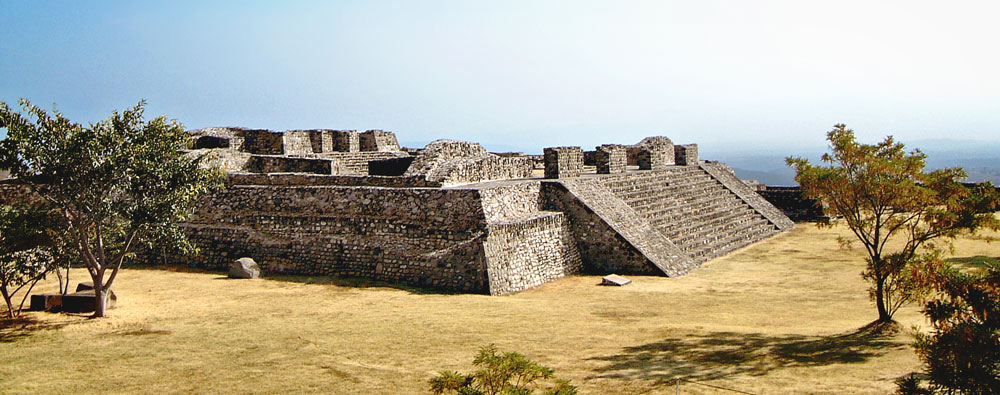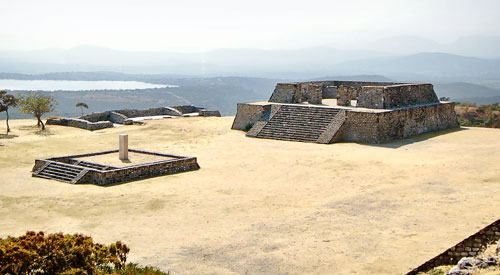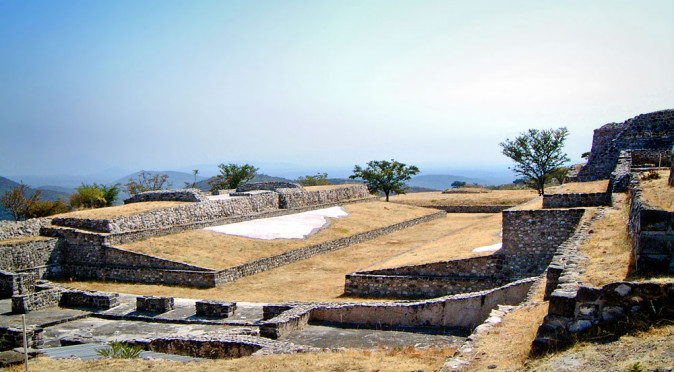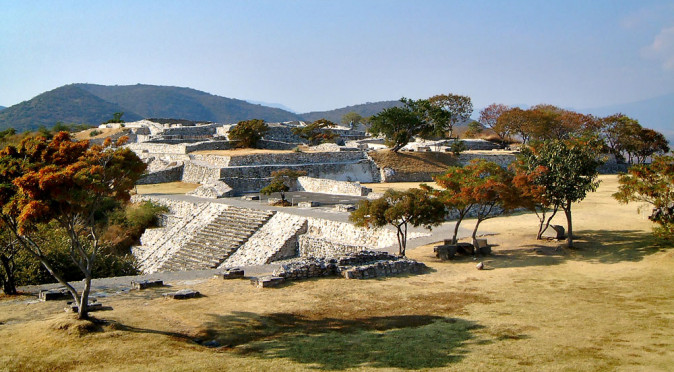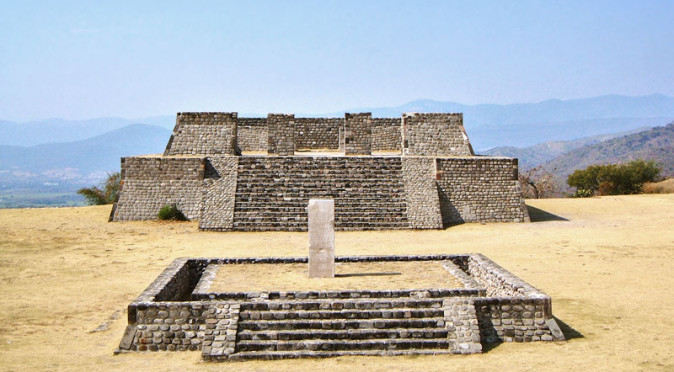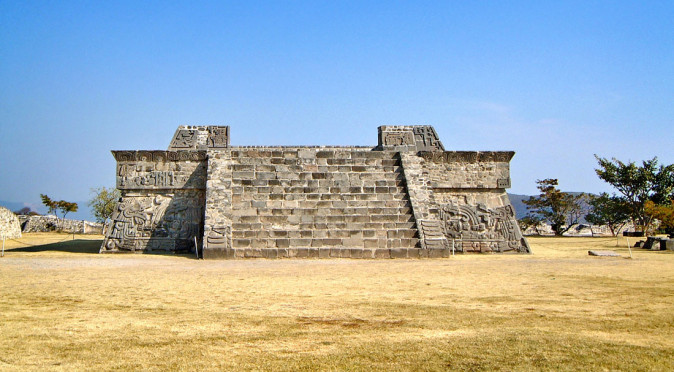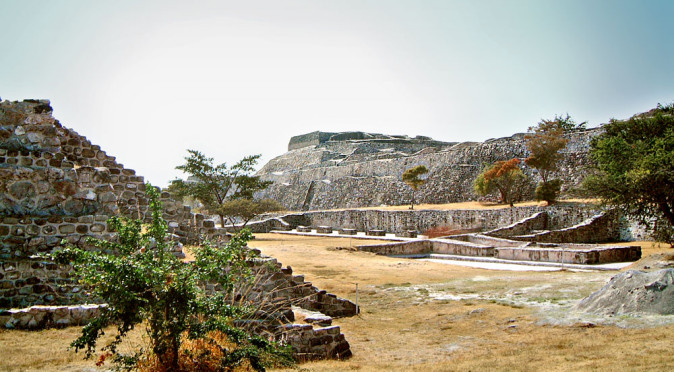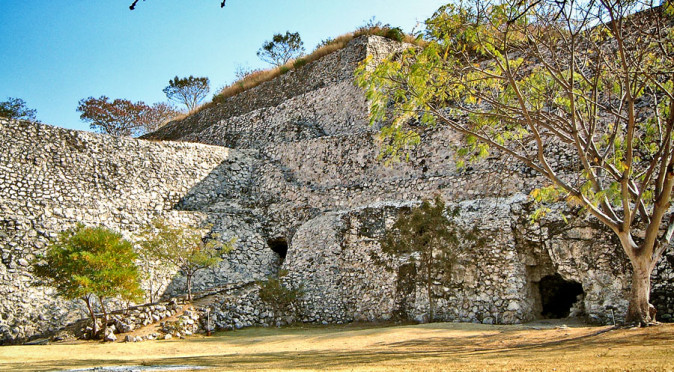Officially listed as Building A and known colloquially as the Templo de los Tres Estelas, the Temple of the Stelae is also called the Pyramid of the Stele, the Pyramid of the Stars and the Temple of the Moon. The Pyramid of the Stelae sits at the southern end of the Central Plaza and features spectacular, uninterrupted views of the surrounding horizons from north-north-east running clockwise around to the west, which makes it an ideal location for observing celestial events. Whilst its neighbour, the Pyramid of the Plumed Serpents, attracts almost all of the documented attention, the Temple of the Stelae is a far more impressive structure to witness.
A number of factors suggest that Temple of the Stelae is a remarkable and unusual addition to the core of Xochicaco’s ceremonial centre. The first of these is its placement seemingly beyond the Central Plaza, and it looks as though the builders had to extend the plaza to make room for it. The Central Plaza would be square, with the acropolis on the western flank and Structure 4 on the eastern-flank both terminating at its southern extent, with a set of stairs down to the next level. From the edge of this squared plaza near the acropolis, you can see the raised platform that was constructed to support the extension of the Central Plaza to accommodate the Temple of the Stelae (see fig W0103 above). 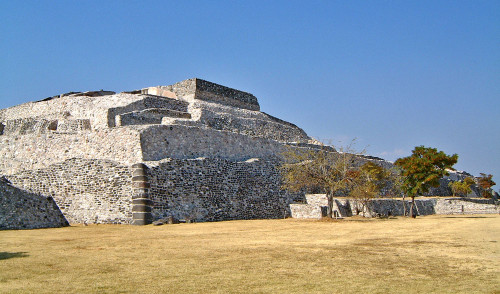 W0089: Rear of the Temple of the Stelae Looking from below at the south-eastern corner, this extension is even more dramatic as the foundations rise imperiously to support the huge pyramidal base of the Temple of the Stelae (see fig. W0089). This suggests that the Temple of the Stelae was not intended to be part of Xochicalco’s core ceremonial complex, and was possibly added later. This is emphasised by the way it overlooks the foundation wall to the west, rather than looking invitingly into the Central Plaza. The result is that it looks like a private area and not part of the complex.
W0089: Rear of the Temple of the Stelae Looking from below at the south-eastern corner, this extension is even more dramatic as the foundations rise imperiously to support the huge pyramidal base of the Temple of the Stelae (see fig. W0089). This suggests that the Temple of the Stelae was not intended to be part of Xochicalco’s core ceremonial complex, and was possibly added later. This is emphasised by the way it overlooks the foundation wall to the west, rather than looking invitingly into the Central Plaza. The result is that it looks like a private area and not part of the complex.
Inside the Pyramid of the Stelae, the concept of a self-contained private complex is further heightened, as the pyramidal base’s stairway leads you up through a private portico and into a secluded patio that is flanked on both the north and south sides by a series of rooms, which were probably both preparation areas and living quarters. In front of the building on the south side of the plaza is a stone structure that was looks to have been an altar. 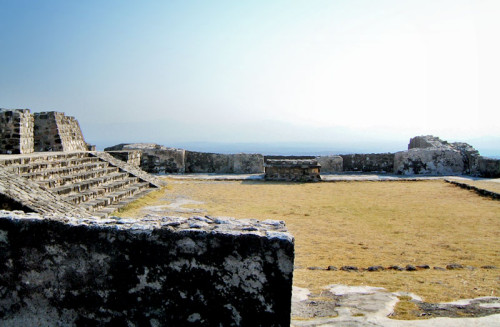
W0110: Interior Plaza of the Temple of the Stelae Finally, at the far end of this private plaza, on its western flank, is set of stairs leading to an elevated temple structure. This self-contained compound bears similarities with Systems M and X at Monte Alban, which is also located high upon a hilltop with very similar surroundings. These peculiar self-contained “Systems” at Monte Alban may have been the work of the Teotihuacano, who took control of the city in the 4th century as they stretched their trading network further and further west to fulfil the needs of their burgeoning city.
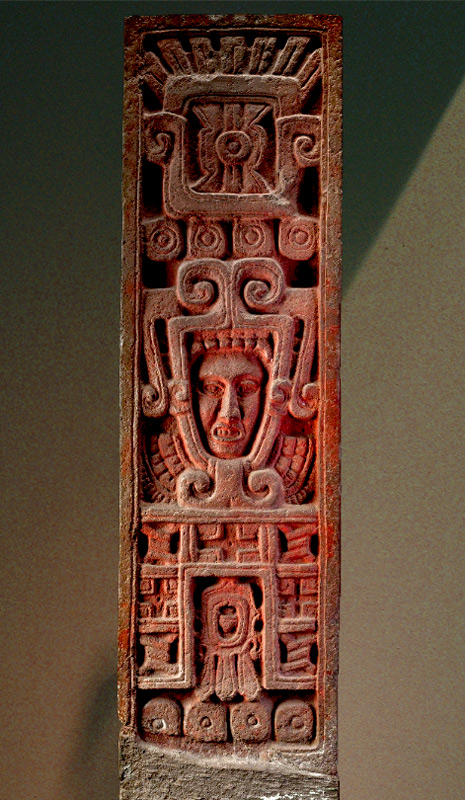
W0108: Stela 2 Evidence of a Teotihuacano and Zapotec influence is further witnessed in the three stelae that were found within the private temple that sits on top of the Pyramid of the Stelae. The stelae were uncovered during excavations in 1960-61 and had were painted red, deliberately broken and buried at the centre of the temple in antiquity – an act that is thought to represent the killing of the statues. They are listed as Stelae 1, 2 and 3 and are now housed at the Museo Nacional de Antropologia in Mexico City. The first Stelae is believed to tell the story of Quetzalcoatl’s transfiguration into the Morning Star, followed by his journey across the sky to visit the Pyramid of the Plumed Serpent, which is pictured on the back, followed by his descent into the underworld – it is principally the story of the 260 day transit of Venus across the celestial sphere as the Morning Star, including an important sighting at Xochicalco. At the top of the second stela, Stela 2 (fig. W0108), is the glyph “4 Movement”, or Nahui Ollin, which is thought to reflect the fourth-age. Beneath the glyph is the same face that is found on Stela 1 and is believed to be Quetzalcoatl emerging from the jaws of a serpent monster (the jaws frame the head, with the teeth visible above the forehead and the curling snout above that, meanwhile a bifurcated tongue flops out beneath the chin – the eyes are probably the curls that are outside the jaws roughly in line with the man’s eyes). Beneath the face is a bleeding heart encased with Mayan style crosses and the twined cord “mat” symbol, with four dots below. This script is thought to relate to the story of Quetzalcoatl sacrificing himself to create the fifth-sun and the age of man, which happens after Quetzalcoatl is reborn as the Morning Star and pulls the sun from the underworld (this act is represented in the sky when Venus is seen on the eastern horizon just above the sun before sunrise). The back of Stela 2 features a building that appears to represent the tiny Temple of Atetelco in Teotihuacan and brings together the concept that Quetzalcoatl created the fifth-sun at Teotihuacan. A number of glyphic representations of Acatl, sacred reed, are possibly designed to assert the relationship between Teotihuacan and the primordial birthplace of civilisation, known as Tollan, which means “Amongst the Reeds”.
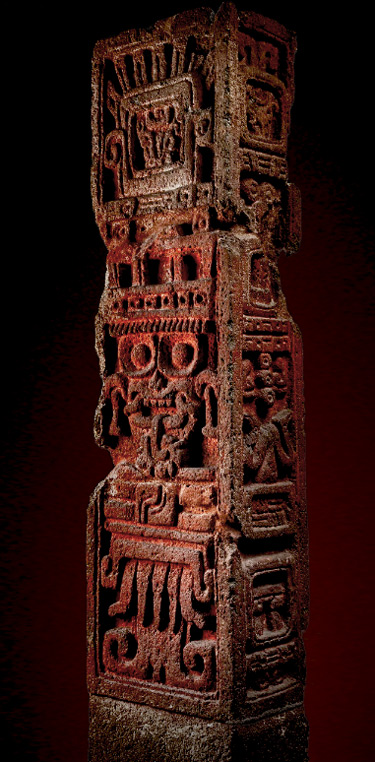
W0107: Stela 3The influence of Teotihuacan is emphasised on Stela 3 (fig. W0107), which features Teotihuacan’s primordial water god, Tlaloc, who is instantly recognisable from his distinctive goggle eyes serpents seeping from the corners of his mouth. However, this central figure may actually be Quetzalcoatl taking the guise of Tlaloc, for the face is situated exactly where Quetzalcoatl appears in the other two stelae. Also, at the bottom of Stela 3 is a lesser known representation of Tlaloc, with the gaping mouth representing a cave entrance, his goofy teeth the stalactites found within and the flopping tongue the sacred water flowing from within the mountain. This concept is quite particular to Teotihuacan, where the imposing Mount Gordo, which frames the Pyramid of the Moon, appears to have been the primary water supply for the megalopolis. This combination of Quetzalcoatl and Tlaloc, or rather Quetzalcoatl playing the role of Tlaloc, serves two purposes. Firstly, it continues the story of the creation of the fifth-sun by detailing Quetzalcoatl’s ability to transform into the wind that blows in the rain-clouds and leads Tlaloc to the fields to feed the maize-seeds that Quetzalcoatl has given to man. Secondly, it demonstrates that Quetzalcoatl was either a form of Tlaloc or superior to Tlaloc, thus promoting the patron deity of Xochicalco.
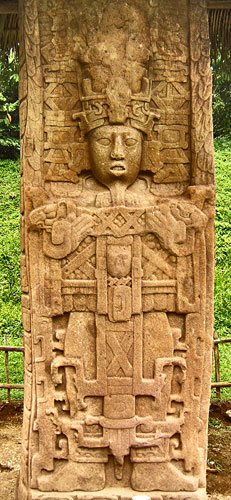
W0968T: Quirigua: Stela C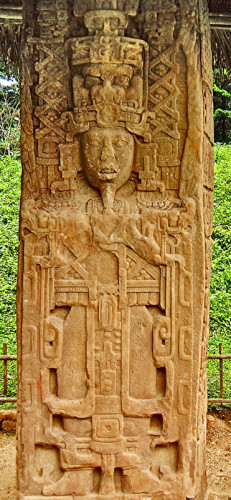
W0960T: Quirigua Stela AThe Stelae of Xochicalco are amongst only a handful carved stelae found in Central Mexico and curiously closely resemble the stelae of Quirigua, a town situated on the south-eastern border of Mesoamerica. There, a pair of stelae erected in the 8th century combine with a zoomorphic altar to tell the story of creation and the binding of three stones at the beginning of the Mayan fourth-sun (see figs W0960T and W0968T and the article on The Mayan Creation Stones). Interestingly, Quirigua was a vassal of Copan and was founded in 425AD almost immediately after a Lord arrived from Teotihuacan via Tikal to assume power at Copan (see the article on Altar Q). It could be a coincidence, but it is certainly plausible that the three stelae erected at Xochicalco were designed to represent the three stones bound together at the beginning of the Mayan fourth-sun.
Through its architecture and monuments, the Temple of the Stelae clearly binds together the three major civilisations of the Classic Era: the Teotihuacano, Zapotec and Maya. It is tempting to think that this magnificent building represented and celebrated a new union – a binding of these three stones of civilisation – and marked the beginning of a new era. The stelae may not be simply recounting the story of the creation, but telling the story of a new creation, a new era, a new religion and a new world order – a union that is likened to the creation myth and the binding of the three stones. This union may also be recorded on the neighbouring Pyramid of the Plumed Serpents, which also bears characteristics of these three major civilisations within its carved walls and architecture.

